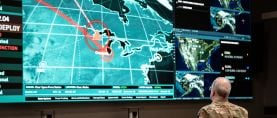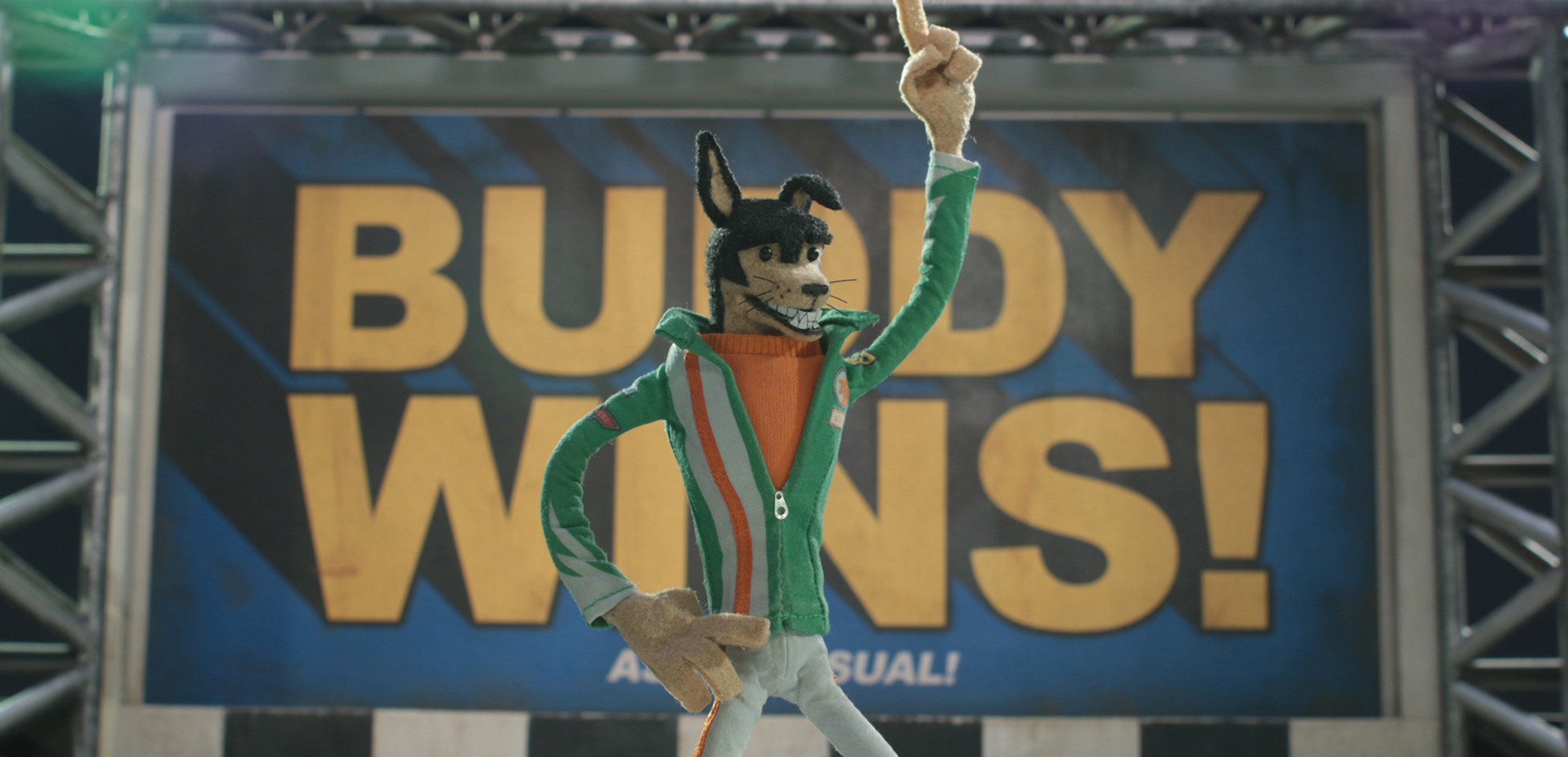
Buddy Thunderstruck: A Dog’s Life
A truck-racing dog embarks upon high-speed adventures in this stop-motion animated series.
A truck-racing dog embarks upon high-speed adventures in the stop-motion animated series Buddy Thunderstruck.
By Kelly Brinker • Unit photography by Jenn Harrington, courtesy of Stoopid Buddy Stoodios and Netflix.
When his son was born, Ryan Wiesbrock began thinking about the kind of television they might watch together someday. And as head of development and production for American Greetings Entertainment, the company responsible for the creation of Care Bears and Strawberry Shortcake, he was well positioned to act on his creative musings. His goal was to “will into existence” a show that embodied everything he loved during his own childhood — cars, ’80s hair-metal music, stop-motion animation and animals.
“When developing Buddy Thunderstruck, [a show about] a dog that races semi-trucks,” Wiesbrock says, “I really wanted to capture the spirit of old car shows like The Dukes of Hazzard and Knight Rider and the Smokey and the Bandit films. I believed that stop-motion animation would be the best way to make the vehicles, the car chases and all that crazy driving feel more tangible. We shopped and sold the series to Netflix, and then were tasked with finding an animation studio for the production.”
As a longtime fan of Robot Chicken, television’s longest-running stop-motion series, Wiesbrock was excited to meet with Stoopid Buddy Stoodios — a production company formed in 2012 when John Harvatine IV and Eric Towner’s Buddy System Studios joined forces with Seth Green and Matthew Senreich at Stoopid Monkey Productions. “We just seemed to connect creatively and sensibility-wise, right off the bat,” Wiesbrock recalls.
Towner adds, “We took a look at the images Ryan created and discussed the concept and the humor of the show. It seemed like the perfect fit, and it had ‘Buddy’ in the title.”
Buddy Thunderstruck would not only be the first children’s series for Stoopid Buddy Stoodios, but also the first original-content stop-motion animated series for Netflix.
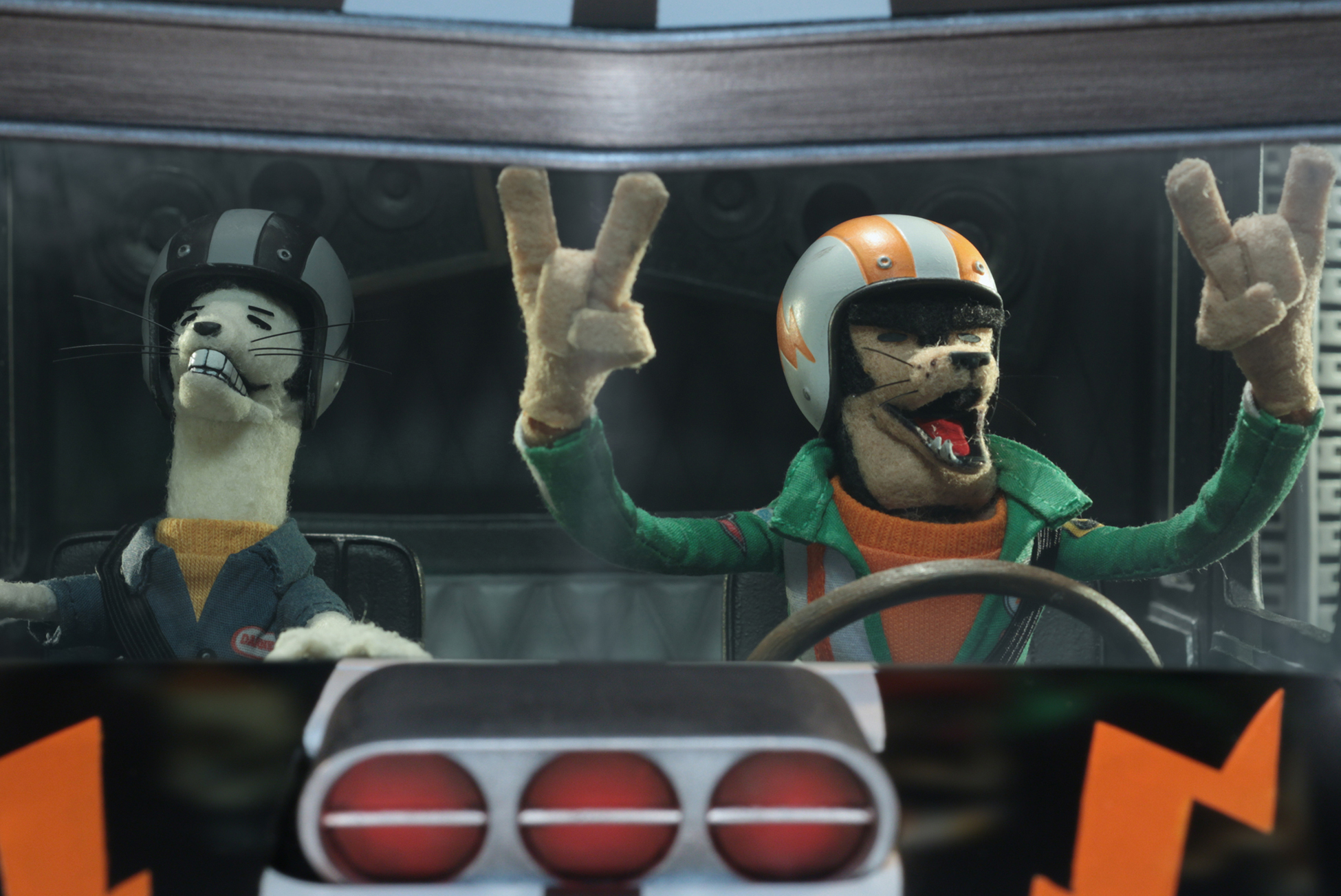
The series takes place in the small town of Greasepit, where Buddy — with his best friend, Darnell, by his side — embarks upon high-speed adventures and enjoys the perks of being a local celebrity. Each of the 12 episodes in the premiere season features two 11-minute narratives, in which Buddy often finds himself in a competitive situation that challenges his ego — but in the end his confidence remains intact.
Towner assumed the director’s chair for the first half of the season, with Harvatine co-directing the pilot and Harry Chaskin and animation director Alex Kamer stepping in to direct later episodes. Wiesbrock, Towner and Harvatine agreed that the comedy was “first and foremost,” and that the look of the show shouldn’t be distracting. They did place fun “Easter eggs” throughout the series, and even created the town of Greasepit to pay homage to Wiesbrock’s hometown in Illinois.
Wiesbrock and Thomas Krajewski, the latter of whom wrote the pilot episode and was head writer/story editor for the series, “pushed the scripts to be as funny as possible,” Wiesbrock says. “[And] Stoopid Buddy pushed things even further in the voice records, boards, comedic timing, animation and direction. They would animate hilarious details that were never in the script, almost improvising on set. There was a spirit of ‘going for it’ and taking creative chances on the stages that helped make the show turn out great.”
Audio recordings began in late October 2015; animatics were then designed, with storyboards synced to the audio; and cinematographer Aaron Wise was brought in for the first animation test in January 2016, thus marking the first director-cinematographer collaboration for Towner and Wise. Wise had originally joined the “League of Buddies” as a camera operator for season seven of Robot Chicken and quickly moved up to cinematographer for the series’ eighth season.
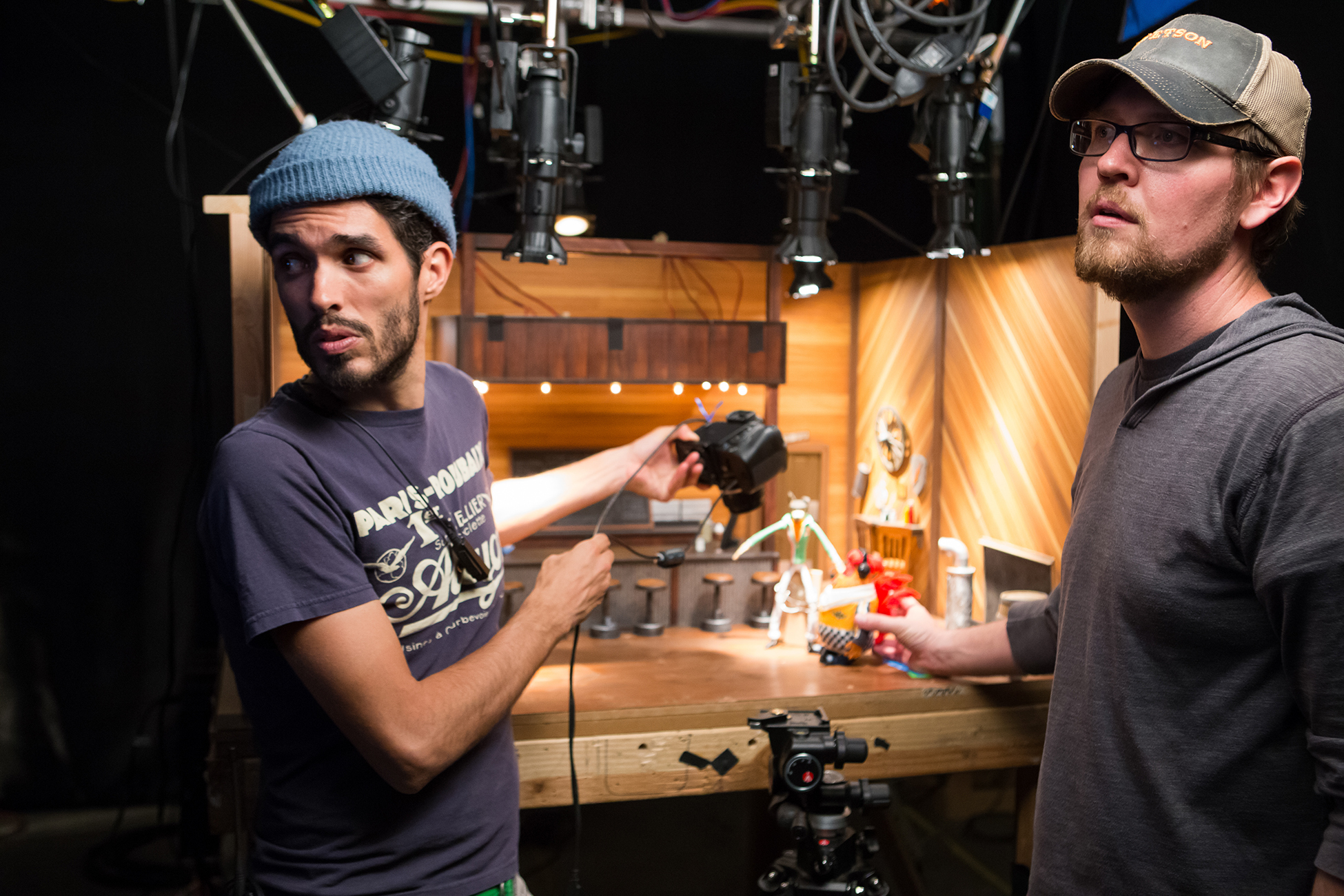
“Aaron and I worked closely to come up with a look for the show that was very documentary-like,” Towner says. “We wanted to make it feel as natural as possible, and trying to do that with a completely artificial environment was a big challenge that we set up for ourselves.”
Stop-motion production for Buddy Thunderstruck officially commenced in February 2016, with Wise bringing in veteran gaffer Dwight Campbell; camera operators Paul Guglielmo and Susie Shircliff; and Andy Malek, who served as an operator and best boy. They began production with only a few stages for truck-interior cab scenes. Within the first month, camera operators Lee Young and Everardo Flores were added to the team, and around 12 animators were working simultaneously across 16 stages. At the height of production, filming expanded to 25 stages with 20 animators.
AC was invited to visit Stoopid Buddy’s campground-styled animation house several times throughout the show’s production, which ran through early October 2016. It was a workout keeping pace with Wise as he zipped from one black-curtain-enclosed stage to another, checking the images captured on the Dragonframe software system employed on each stage.

“Dragonframe has quickly become the standard capture software for stop-motion,” Wise explains. “The program features several different windows for each aspect of the production. There is a window for the animator where the audio track is broken down and split up frame by frame with phonetics. There is a cinematography window that gives me access to all the controls on our Canon cameras. I can control the exposure time and there is even a digital densitometer. There’s also a DMX window that functions like a lighting board; you can fade the lights up and down, or program fades using keyframes to certain levels.”
Towner adds, “There is so much control and fine tuning on set through Dragonframe that we can get the image pretty close to what we want for the final output. This allows us to create more visual effects in camera and really bring the action sequences to life.”
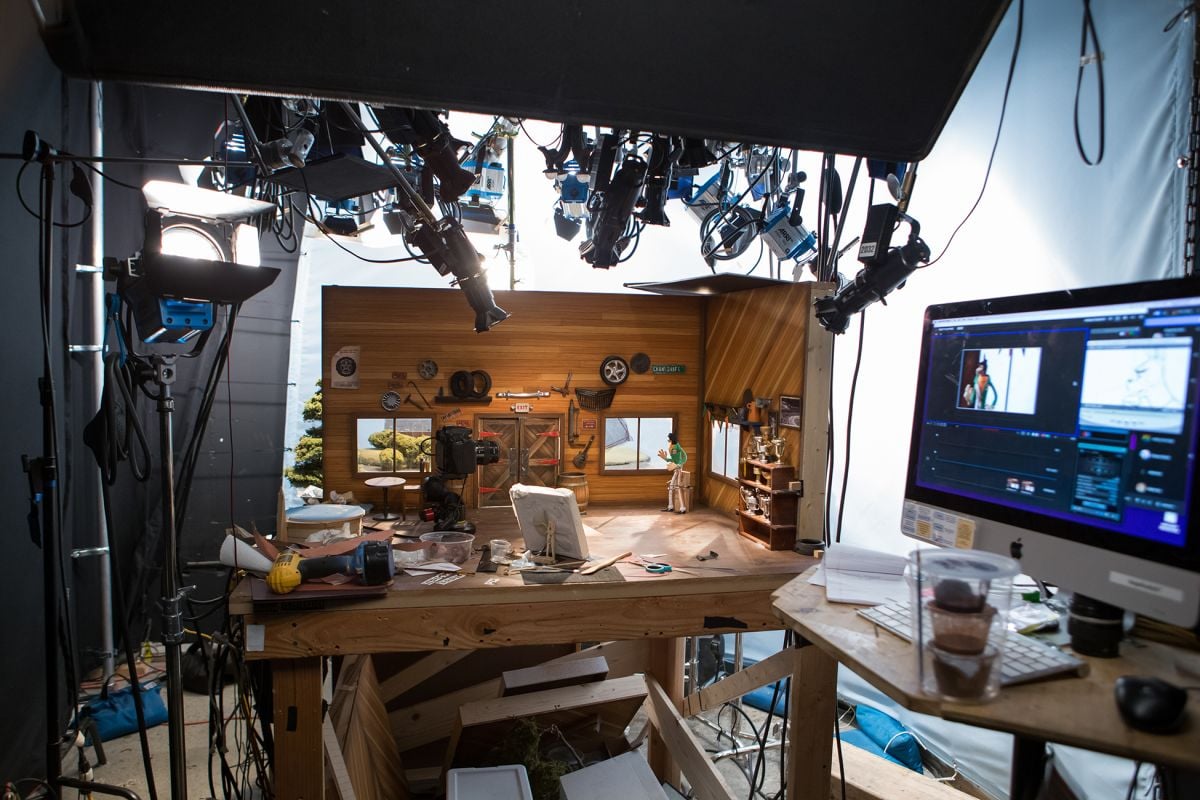

Each stage was outfitted with a Canon EOS 70D camera, which was often mounted on a tripod that was hot-glued to the floor to prevent unnecessary movement and to maintain the desired shooting angle. “JPEG files from the camera were captured in Dragonframe on a tethered computer,” Wise explains, adding that there was one computer for every camera.
With the aid of adapters, the cameras were fitted with a variety of manual Nikon Nikkor prime lenses. A polarizing filter was used in all cases to control unwanted glare on the puppets. With the cameras set at 200 or 400 ISO, the lenses were often set to a wider aperture to create a more cinematic look, with a shallow depth of field not often used in stop-motion animation due to the challenges it presents for the animators. Wise reports that the aperture on the production ranged from f4-f22. The cinematographer adds that Zeiss ZF.2 primes were used “on select shots that required deep focus — f22. These lenses are much higher resolution, especially at that stop.”
Once the art, puppet, costume and visual-effects departments have had a last look, the camera department “launches” the stage and closes the curtain — and left to make the magic happen is the animator, tasked with manipulating the puppets in order to bring them to life, one frame at a time.
For the animation of the puppets, 24 frames were required to create one second of action. “Animation was done on ‘twos,’” Wise notes. “So most poses were photographed twice for 24 fps.” The racing scenes were 18 frames per second, allowing for a smoother moving image while still maintaining the feel of stop-motion. For efficiency, a number of stock racing scenes were captured that could be used in every episode.
“When the trucks are moving really fast, you run out of real estate very quickly,” Towner explains. “We had a couple of shots where we were tracking along with the truck and we would get to the end of the set, and just go back to the beginning of it, creating an invisible cut in the sequence.”
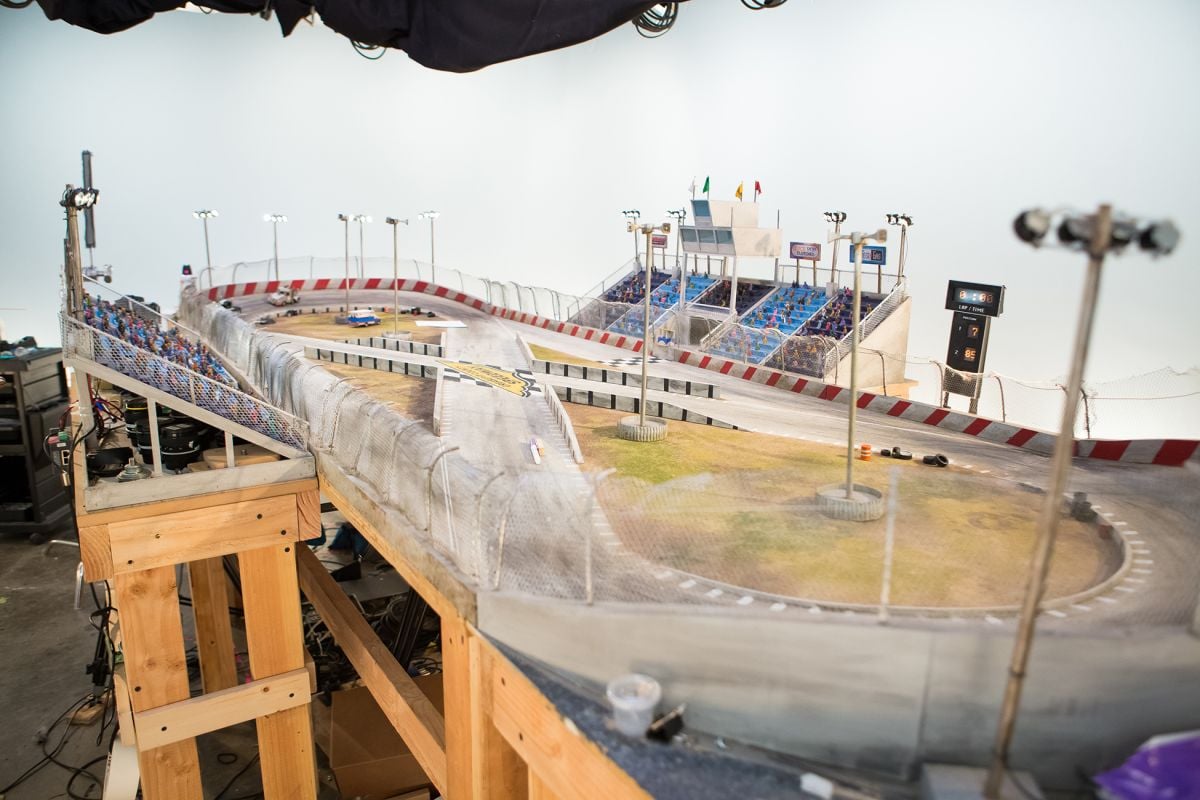
The largest and most challenging set to prepare for the production was the 6'x12' figure-eight mini-speedway, where the townspeople race their semi-trucks. With the trucks at 1:43 scale for the racing scenes, the set was designed to allow for shooting in any direction and required 350 degrees of sky visibility, with just a small sliver without coverage.
With the majority of the racing scenes taking place at night, 64 1-watt LEDs were custom-built into the set as on-camera stadium-lighting practicals, which Wise supplemented with four Arri 150s. Around the outer edge of the set, 20 covered wagons, each containing two photofloods, were positioned to give off a slight orange tint, “creating the effect that there is something going on beyond the horizon,” Wise says.
For fill light, four Arri Studio Cool 4s — two fitted with tungsten-balanced tubes and two with daylight — were bounced off muslin. Employing Dragonframe’s automated DMX lighting-board functionality, Wise adjusted the color temperature of the fill, fading more toward the blue during night scenes for a moonlight effect. For daytime scenes, Wise and his crew employed 18 Arri 300s, four Arri 650s and the covered wagons to light the sky. Two Arri T1s were set as key light, with “one at each end of the speedway,” Wise says. “One or the other played as a back key light, depending on which way we were shooting.”
During the production of Robot Chicken, a custom rig dubbed the “E-Mover,” invented by Ethan Marak, has been employed to capture sequences that would normally be achieved with a Steadicam on a conventionally scaled production. For the speedway racing scenes in Buddy Thunderstruck, Guglielmo created a smaller E-Mover customized specifically for Olympus Air A01 cameras. This rig allowed the camera to capture racing footage from a low angle as it moved steadily and seamlessly between the trucks on the speedway.
“[The E-Mover] helps put the animator in the mindset of being a camera operator, giving them control over the camera as well as the character,” Towner says.

The A01 bodies were paired with Voigtlander Nokton 10.5mm lenses that featured Micro 4⁄3 mounts. Wise explains that the Olympus cameras were “mostly used on the speedway, but exclusively for 1:43-scale truck shots.” Programmers at Dragonframe wrote custom code specifically for this production that added support for the Olympus Air cameras.
The majority of postproduction was completed in-house and occurred simultaneously with production, which is standard procedure at Stoopid Buddy.
Wise and colorist Sparkle performed color correction at the Technicolor offices in Hollywood with Blackmagic Design DaVinci Resolve, for a ProRes 4:4:4, 1920x1080 final deliverable. An important element of the grade was creating consistency among scenes ostensibly taking place on the same set that were actually shot on different stages. Another priority was desaturating colors to maintain the natural, documentary-style look that Towner and Wise sought for the production.
“I was blown away — from the first animation tests, to the weeklies, to the final show,” Wiesbrock says of his experience on Buddy Thunderstruck. “I had high expectations, and it turned out even better than I imagined. I couldn’t be happier.”
TECHNICAL SPECS
| Aspect Ratio | 1.78:1 |
| Stock | Digital Capture |
| Cameras | Canon EOS 70D |
| Olympus Air A01 | |
| Lenses | Nikon Nikkor |
| Voigtlander Nokton | |
| Zeiss ZF.2 |
